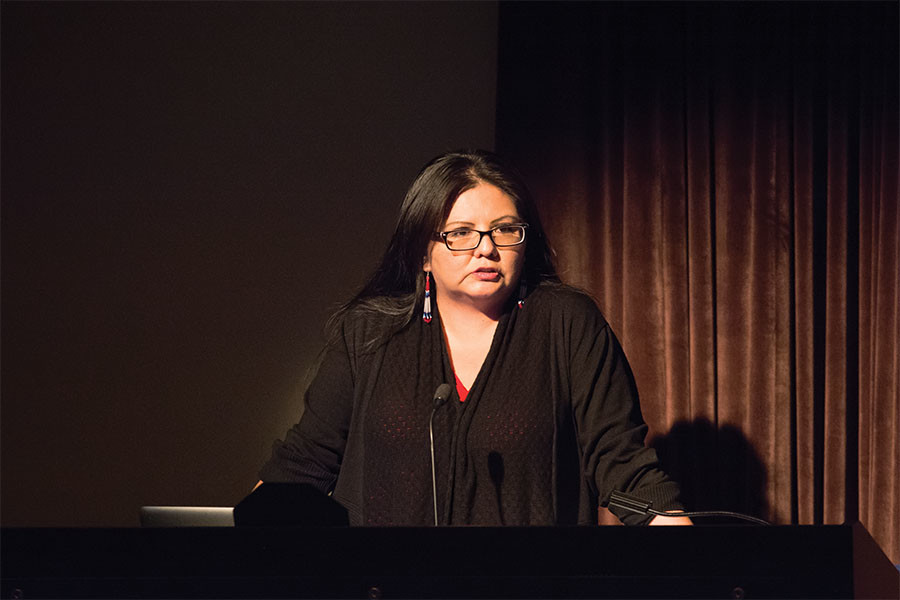Navajo filmmaker discusses Native American experiences of urban relocation
Jeffrey Wang/The Daily Northwestern
Navajo artist and filmmaker Pamela Peters discusses her recent multimedia project on Native American youth in Los Angeles at Helmerich Auditorium on Thursday. Peters also spoke about the challenges facing “Modern Indians” like cultural appropriation and assimilation.
November 20, 2015
Navajo filmmaker and artist Pamela J. Peters explored the “modern Indian” in discussion Thursday night around her latest multimedia project.
More than 15 people attended the gathering at Annie May Swift Hall, where Peters presented the project, Legacy of Exiled NDNz, and spoke on the challenges of Native Americans in modern, urban communities on Thursday night. The event was co-sponsored by the Multicultural Filmmakers Collective and the Native American and Indigenous Student Alliance.
Peters’ project examines the lives of seven young Native American adults from various tribes in Los Angeles, who she said either have moved off their reservations or are the offspring of those displaced by the Bureau of Indian Affairs’ Relocation program in the 1950s and 60s.
“My entire mission is to dispel the image of the dying Indian,” she said. “I want people to understand American Indians without cliches.”
The short film is made up of black and white photos and video, juxtaposed with clips from “The Exiles,” a 1961 film by Kent Mackenzie that tells the story of a group of young Native Americans who left the reservation during relocation for Los Angeles.
Peters said her goal was to create a similar, neo-realistic portrait of what Mackenzie did in “The Exiles.”
“I want my images to invoke a contemporary sensibility, the reality of the vibrant, passionate smiling Indians living in urban worlds of yesteryears to today,” she said.
Through these stories, Peters hopes to show the real lives of young American Indians living in urban environments and counter inaccurate portrayals of Indians within mass media, including television, fashion, sports and movies
“Our existence is something of a relic, something that is counted, something that is commodified,” Peters said. “Most people believe in the negative and fictional ideologies conveyed by people from non-native land.”
Peters said that contrary to popular belief, Native Americans have not disappeared and maintain tight-knit, communities in urban environments, especially Los Angeles, which she called a “Pan-Indian reservation.”
“We have a history to Los Angeles but the contributions have never been told,” Peters said. “I want people to really engage and redefine and reimagine who we are as Indians today.”
Planning for the event began in June, said Communication senior Emelyn Barrientos, a co-programming chair for the Multicultural Filmmakers Collective. Barrientos said she and her partner, Communication senior Natalie Frazier reached out to roughly 10 Native American filmmakers and eventually settled on Peters due to her unique project and background.
Frazier said Peters’ existence is revolutionary.
“You have a Navajo woman who’s making film,” she said. “She’s depicting people who have been erased from history.”
Barrientos also commended Peters’ work for the unique format and said the stories of native youth have particular relevance for students at Northwestern.
“A lot of people forget that the majority of Native American people live in urban environments,” Barrientos said. “It’s also important to realize that there are many different identities that come from this group like any other minority group ”
This post has been updated to clarify the event’s sponsors.
Email: [email protected]
Twitter: @DanielAaron1007


